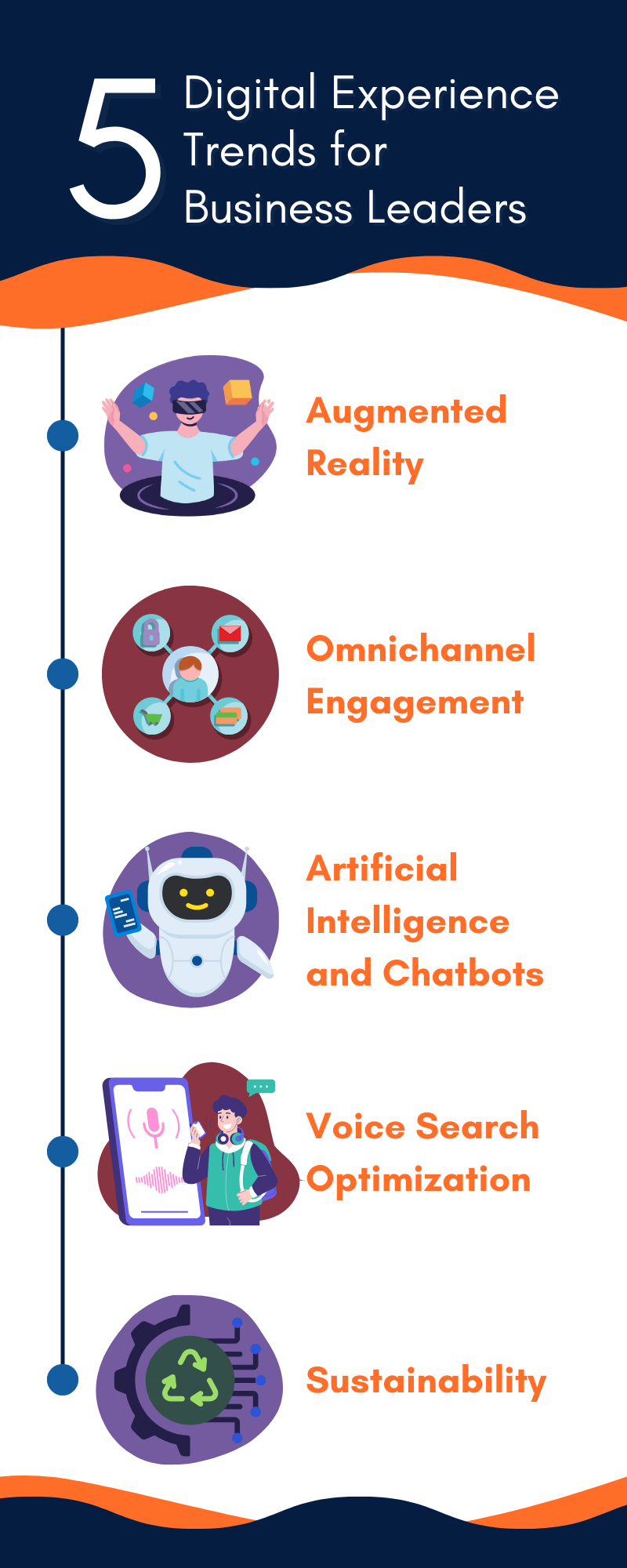Understanding the latest digital experience trends has never been more important for businesses looking to thrive in an evolving market. At ValueBound, we focus on not just building solutions but creating meaningful partnerships that help businesses grow by redefining their digital experiences. The way customers interact with technology is changing rapidly, and staying ahead of these shifts can make all the difference in how deeply you connect with your audience.
Let’s dive into five essential digital experience trends that every business leader should watch closely.

1. Augmented Reality
By blending the physical and digital worlds, AR offers immersive experiences that captivate users, providing a new dimension to digital interactions. As more companies adopt this cutting-edge technology, it’s clear that AR is a powerful tool for enhancing customer engagement and driving business growth.
Why Augmented Reality Matters
- Enhanced Customer Engagement: With AR, customers can try on virtual clothes and see furniture in their home, thus enabling a customer to interact with a product in ways that were not possible before.
- Immersive Product Experiences: Customers can use real-world settings in order to conceptualize the effects of actual products, thus helping them make better decisions and get more desirable outcomes.
- Increasing Adoption Across Industries: The use of AR is no longer restricted to any industry, as influencer brands such as Sephora and L'Oréal as well as for virtual tours of real estate homes for potential homebuyers.
How to Implement Augmented Reality
- Product Visualization Tools: Develop an AR app or integrate AR features into your website to enhance the interactive and engaging experience for the customer shopping process.
- Virtual Try-On Experiences: By allowing customers to see how a product looks on them, you increase confidence in their buying decisions, reducing the likelihood of returns and increasing satisfaction.
- AR-Enhanced Customer Support: AR can be used to help the customer troubleshoot their problem by overlaying digital instructions on a physical object in real-time.
- AR in Marketing Campaigns: Ads, games, or experiences can engage the customer creatively. This creates higher brand visibility, and better engagement rates, and drives stronger emotional connections with your audience.
- Location-Based AR Experiences: Retailers will be able to use AR to connect customers to special in-store offers while tourism and hospitality sectors can offer AR-driven tours, and interactive guides for visitors.
2. Omnichannel Engagement
Today's customer experiences the brand on various channels: it could be a website, social media, mobile apps, or even a store visit. The key to success can be achieved through an effortless experience across all these touchpoints.
Why Omnichannel Matters
- Consistency: A customer of your brand should be given a consistent experience wherever and in whatever way they are going to interact with your brand. If they see an advertised message on your website, they should be able to view the same on your app or other social media platforms as well.
- Higher Customer Satisfaction: A good omnichannel strategy will ensure a seamless transition between channels. For example, customers can begin shopping from their mobile; however, once they click on the link, they get an email containing even more special deals and complete their purchase from a computer. This also helps build trust.
How to Implement Omnichannel Engagement
- Unified Communication: You can work through just one CRM to track interactions across all channels. From this, your team will be able to provide informed support and reach out to a customer appropriately.
- Cross-Channel Promotions: Incentivize customers to interact across different platforms. So, for instance, give them a discount the moment they make purchases via your mobile app after interacting with your social media posts
This omnichannel approach, therefore, enhances the customer experience, maximizes sales, and contributes to loyalty for the brand.
3. Artificial Intelligence and Chatbots
The integration of AI and chatbots is transforming how businesses interact with their customers. These tools can handle routine inquiries, provide instant responses, and significantly enhance the overall customer experience.
Benefits of AI and Chatbots
- 24/7 Availability: Customers can receive assistance any time of the day, which is especially valuable for global brands with diverse customer bases.
- Data Collection and Insights: Chatbots can gather data during interactions, helping businesses understand customer preferences and pain points.
How to Effectively Use AI and Chatbots
- Set Clear Expectations: Ensure customers know they are interacting with a bot. Clarity helps manage expectations and improves the overall experience.
- Human Touch: While chatbots can handle many queries, ensure that customers can easily escalate to a human agent for complex issues. This combination enhances satisfaction.
- Regularly Update Knowledge Bases: Continuously improve the chatbot's knowledge and capabilities to ensure it can handle a wide range of questions and scenarios.
AI-driven customer support not only enhances efficiency but also ensures that customers feel heard and valued.
4. Voice Search Optimization
With the rise of smart speakers and voice assistants, optimizing your digital content for voice search has become essential. It’s a significant shift in how consumers seek information.
Why Voice Search Matters
- Growing Adoption: More consumers are using voice search to find products and services. Optimizing for voice search allows your business to reach this expanding audience effectively.
- Natural Language Processing (NLP): Voice search is fundamentally different from text-based search. Consumers tend to use more conversational phrases when speaking, which means your content must reflect that natural language.
Strategies for Voice Search Optimization
- Long-Tail Keywords: Focus on long-tail keywords that reflect how customers phrase their queries verbally. Instead of targeting "shoes," aim for "best running shoes for women."
- FAQ Pages: Create content that answers common questions about your products or services. This format aligns well with voice search, as customers often ask questions in full sentences.
- Local SEO: Many voice searches have local intent. Ensure your business is optimized for local SEO, including your Google My Business listing.
Optimizing for voice search enhances visibility and makes it easier for customers to find you when they need your products or services the most.
5. Sustainability
Modern consumers are more conscious about the environmental and social impact of their purchasing decisions. They want to support businesses that take responsibility for the planet. Failing to integrate sustainability into your business model means risking the loss of a growing audience that values ethical and eco-friendly practices.
Why Sustainability Matters
- Growing Consumer Consciousness: More people are choosing brands that prioritize sustainable practices, such as reducing waste, using renewable energy, and ensuring ethical labor standards.
- Brand Success Stories: Patagonia’s commitment to environmental activism, such as its pledge to donate profits to environmental causes, and Unilever’s responsible sourcing of materials have earned them a strong, loyal following.
How to Implement Sustainability in Your Business
- Choose Eco-Friendly Materials: Look for suppliers that offer recycled, biodegradable, or ethically sourced products. Whether it's using eco-friendly packaging or sustainable raw materials, this step shows customers that your business cares about reducing its environmental footprint.
- Minimize Carbon Footprint: Invest in energy-efficient processes, switch to renewable energy sources where possible, and focus on reducing waste throughout the supply chain.
- Implement Ethical Labor Practices: From sourcing materials ethically to treating workers fairly, businesses can create a positive social impact while enhancing their reputation among socially conscious consumers.
- Promote Circular Economies: Creating a circular economy means designing products that can be reused or recycled at the end of their lifecycle, reducing waste, and conserving resources.
Staying Ahead
Staying ahead in the digital world requires a proactive approach to understanding and implementing the latest digital experience trends. By focusing on personalization, omnichannel engagement, AI integration, voice search optimization, and data privacy, businesses can significantly enhance their digital customer experience.
As a business leader, the responsibility lies with you to ensure that your organization not only meets but exceeds customer expectations. We, at ValueBound, are committed to helping you navigate these changes and thrive in your digital journey.
Are you ready to redefine your digital world? Contact our experts at ValueBound today to discover how we can help your business grow through innovative tech partnerships.
FAQs
1. What are the top digital experience trends businesses should focus on?
The top trends include AI-powered personalization, omnichannel experiences, voice interfaces, augmented reality, and hyper-personalization.
2. How can AI-powered personalization enhance the digital customer experience?
AI helps businesses tailor content, recommendations, and services based on individual customer preferences, improving engagement and satisfaction.
3. What is the importance of offering seamless omnichannel experiences?
Seamless omnichannel experiences ensure customers can switch between platforms effortlessly, boosting brand consistency and customer loyalty.
4. How can augmented reality (AR) improve customer engagement?
AR allows businesses to offer immersive experiences like virtual try-ons or interactive product demos, enhancing customer interaction and decision-making.





